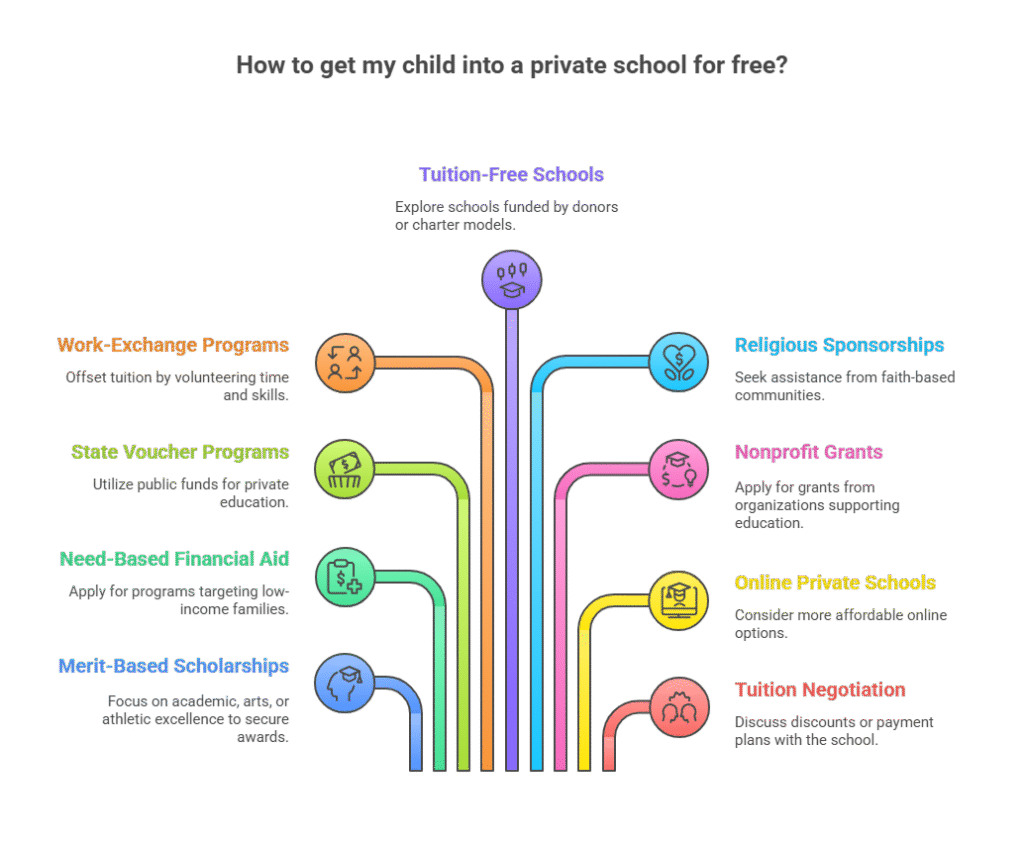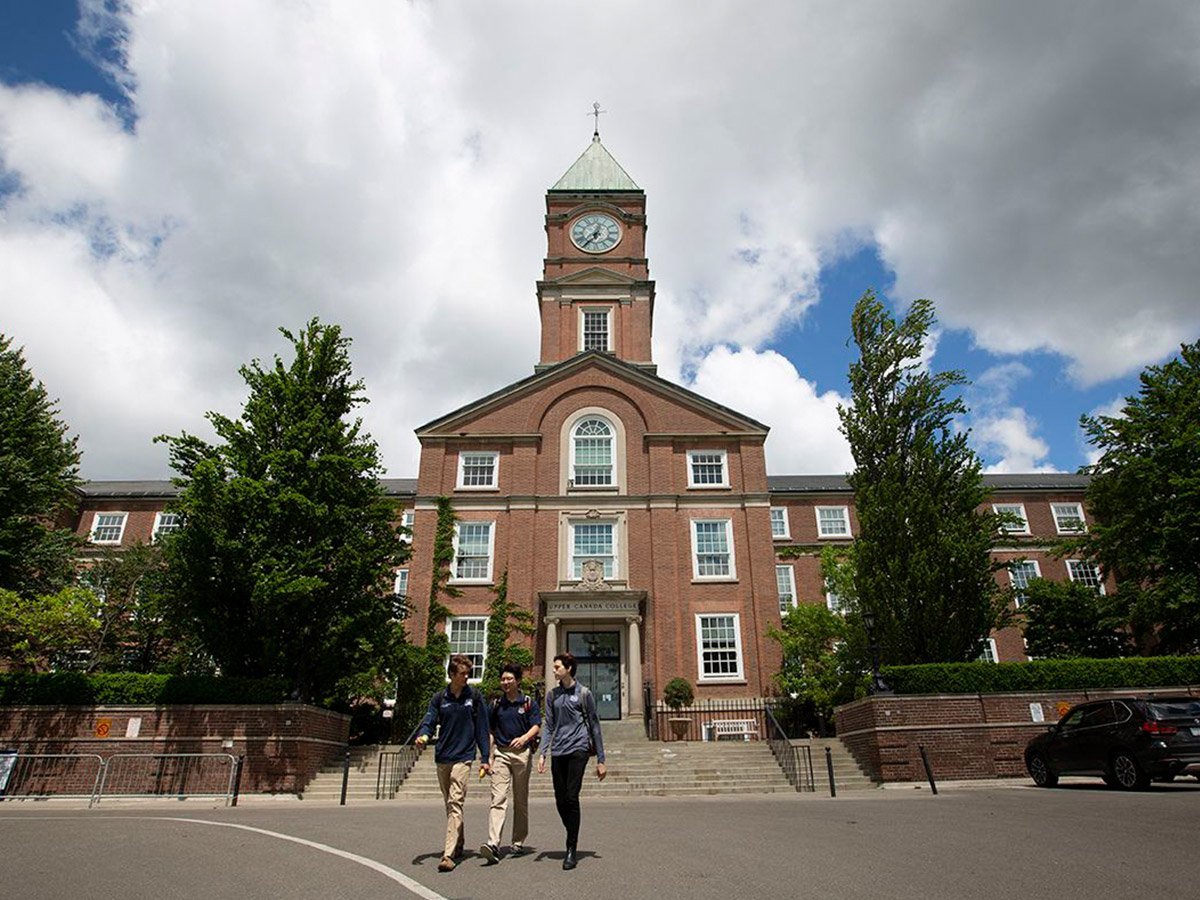How can I get my child into a private school for free? When public schools fall short of offering the academic environment your child needs, private schools stand out for their excellence, but often come with a high price tag. Surprisingly, 65% of families assume private schools are unaffordable, yet many students attend at little to no cost.
But let’s face it-private schools are expensive. The average tuition can range from $10,000 to $30,000 or more per year, depending on the institution and location. Unsurprisingly, nearly 65% of families believe private education is out of reach. Yet here’s the surprising truth: thousands of students attend private schools every year at little to no cost.
Here’s the actionable good news: there are realistic, proven ways to reduce or even eliminate tuition fees. From academic scholarships and need-based financial aid to church sponsorships and nonprofit grants, the possibilities are more accessible than many families realise. In this blog, you’ll discover nine effective strategies that can help you unlock a quality private school education without the financial stress. How to reduce private school fees to zero cost often involves combining scholarships, need-based aid, and work-exchange programs.
Whether you’re planning for kindergarten or high school, this guide will walk you through the resources, programs, and steps you can take today to make free private education a reality for your child.
How Can I Get My Child Into a Private School for Free: 10 Steps Every Parent Should Know
Accessing free education for a child in a private school is possible with the right combination of financial aid and nonprofit grants. Before we dive in, it’s important to understand why these strategies work. Many private schools are backed by donor endowments, state partnerships, or religious organisations. With rising demand for equity in education, more institutions are creating access pathways for low- and middle-income families. Many families are exploring how can I get my child into a private school for free through scholarships, bursaries, and donor-funded programs.
1. Apply for Merit-Based Scholarships
Private schools often reward student excellence through academic, arts, or athletic scholarships. These merit-based awards recognise talent and achievement, regardless of financial need.
Unlike need-based aid, merit scholarships focus on performance, potential, and passion. They’re often funded by alumni, donors, or school foundations and can cover partial to full tuition.
To boost your child’s chances, focus on:
- Academic Excellence – High grades, strong test scores, and consistent performance
- Extracurricular Involvement – Sports, debate, music, robotics, theatre, etc.
- Special Talents or Skills – Unique abilities in arts, STEM, leadership, or community service
- Strong Recommendations – Endorsements from teachers, mentors, or community leaders
- Impressive Portfolios – For art, music, writing, or athletic scholarships, prepare a professional-grade submission.
Quick Tips:
- Research schools that offer automatic merit consideration during admissions.
- Some schools require a separate scholarship application, essay, or interview.
- Keep track of deadlines-most merit awards have early application cut-offs.
- Encourage your child to apply to multiple schools to increase opportunities.
Example: Many schools offer entrance scholarships based on entrance exam scores, such as the SSAT or internal school tests. Others may offer named awards tied to leadership or innovation.
With preparation and a standout application, merit-based scholarships can be your child’s ticket to a high-quality private education, completely tuition-free. Private schools in Mississauga offer high-quality education with small class sizes, diverse programs, and strong university placement records.
2. Explore Need-Based Financial Aid
Need-based financial aid targets low-income families or those facing financial hardship. Most private schools offer these programs, allocating a portion of their annual budget to broaden access. Parents often search for how can I get my child into a private school for free near urban centres or within their local school district. A private high school provides personalized learning, advanced curriculum options, and a strong focus on student success beyond graduation.
According to the National Association of Independent Schools (NAIS), over 25% of private school students receive some form of aid. However, schools often award limited funds on a first-come, first-served basis.
Per Statistics Canada, 1 in 7 private school students in Canada pays less than 50% of the total tuition, indicating strong financial accessibility when you know where to look.
After applying these strategies, Toronto mom Lena secured 90% tuition coverage at St. Michael’s College School through need-based aid and a Prosser Foundation grant.
3. Look for State or Regional Voucher Programs
Education vouchers can drastically reduce or eliminate private school tuition. These are offered by some U.S. states and Canadian provinces, allowing families to use public funds toward private education. Earning a secondary school diploma from an accredited private institution opens doors to top universities and global opportunities.
Examples include Florida’s Family Empowerment Scholarship (FTC) and Ohio’s EdChoice Program in the U.S. In Canada, voucher-style supports exist in select provinces:
- Alberta’s Funding Manual for Private Schools outlines tiered subsidies covering 60-70% of costs.
- In Quebec, the Subsidised Private Schools Program covers up to 60% of tuition for accredited institutions such as Collège Jean-de-Brébeuf, provided the school meets provincial curriculum standards.
Check provincial ministry websites to explore programs near you and eligibility criteria.
4. Research Work-Exchange or Volunteer Programs
Not all tuition discounts come from financial aid or scholarships-some private schools offer work-exchange or volunteer programs that allow parents to offset tuition costs by contributing their time and skills. This arrangement creates a win-win: the school benefits from additional support, and families receive significant tuition reductions or fee waivers.
These programs are especially common in smaller, community-driven, or faith-based schools, where parent involvement is both encouraged and valued. In many cases, parents may not need specific qualifications a willingness to help out in meaningful ways. Families researching how to access free private school education options should explore nonprofit grants, tuition-free academies, and state-funded support.
Common work-exchange roles include:
- Administrative tasks (office support, reception, filing)
- Maintenance & facilities assistance (light repairs, janitorial help, gardening)
- Cafeteria or lunchroom help
- Event staffing (fundraisers, open houses, school fairs)
- Classroom or library support (especially for parents with educational backgrounds)
- Transportation or school pick-up/drop-off duties (in certain rural or tight-knit communities)
Case Example:
At a Montessori school in Ontario, parents who volunteered 10+ hours per month received a 25% tuition reduction. Another private religious academy allowed one parent to serve as a part-time office assistant in exchange for full tuition coverage.
Tips to access these opportunities:
- Ask about “parent participation” programs during the admissions process
- Offer a résumé or skills list if you have relevant experience (e.g., accounting, IT, teaching, carpentry)
- Clarify the hours required, expected duties, and whether the discount is partial or full.
- Check if work-exchange can be combined with financial aid or sibling discounts.
Note: Spots in these programs may be limited and filled on a first-come basis, so inquire early in the school year.
By trading time and effort for reduced tuition, work-exchange programs make private education more accessible for families who are willing to contribute hands-on support.
5. Apply to Tuition-Free Private Schools
Yes, they exist. Tuition-free private schools operate through donor funding, work-study models, or charter-based structures. Understanding how to qualify for free private school tuition starts with demonstrating financial need, academic merit, and timely application submission.
Examples include:
- Cristo Rey Network (U.S.) – Combines work-study and private education
- NYC’s Success Academy – Charter model offering free private-equivalent schooling
- Athol Murray College of Notre Dame (Canada) – Offers scholarships to cover full tuition based on merit and need
Schools compete for limited seats, and eligibility often includes family income, student motivation, and academic standing.

6. Check for Church or Religious Sponsorships
Many religious schools partner with churches to offer tuition assistance or full sponsorship for families involved in faith-based communities.
Case Study: Maria, a single mother from Hamilton, Ontario, secured a full scholarship for her daughter through her church’s education sponsorship fund, combined with a work exchange at the school cafeteria.
Inquire at your place of worship or local diocese-they often support parishioners seeking faith-aligned education.
7. Utilise Education Nonprofits and Community Grants
Numerous nonprofit organisations support access to private education for underprivileged families. They offer grants, mentorship, and sometimes full scholarships. Yes, there are free private high schools available through religious sponsorships, government-subsidised programs, and scholarship-based institutions.
Top organisations include:
- Children’s Scholarship Fund – Apply Here
- A Better Chance – Apply Here
- Jack Kent Cooke Foundation
- Black Student Fund
In Canada, the Prosser Foundation and Bursaries Canada provide assistance for eligible independent school students.
8. Find Online Private School Options
Private online schools can be more affordable than traditional day schools. Some are fully funded by governments or supported by donations.
In Canada, publicly funded options like Open School BC or Alberta Distance Learning Centre offer free online education. Private programs like Ontario Online Institute require tuition, unless scholarships apply.
Make sure any online school is accredited and recognised by local education authorities. Enrolling in digital academies is a smart option for those considering how I get my child into a private school for free online.
9. Negotiate Tuition or Ask for Discounts
Many private schools are more flexible with tuition than families realise. Especially if you’re enrolling multiple children or applying mid-year, administrators may offer discounts, extended payment plans, or sliding scale fees. To begin your journey, learn how to access free private school education options through local school directories, financial aid offices, and education advisors.
Tip: Be proactive-schedule a conversation with the admissions office and respectfully ask if there’s room for negotiation or unlisted financial aid options
10. Ways to Send My Child to Private School Without Paying
You can send your child to a private school without paying by applying for full scholarships, bursaries, or tuition-free private schools. Some institutions offer need-based aid, corporate sponsorships, or work-study programs that fully cover costs. It’s also worth exploring religious or mission-based schools, which often support low-income families through generous funding.
Can My Child Attend Private School on a Scholarship?
Schools offering free private school programs for low-income families can significantly reduce the burden of education expenses.
Yes, and it’s more common than many assume. Scholarships fall into several categories:
- Academic Scholarships – Based on grades, test scores, or subject expertise
- Athletic Scholarships – For outstanding performance in sports
- Arts-Based Scholarships – For gifted students in music, dance, or visual arts
- Leadership & Community Service Awards – For students who demonstrate initiative or contribute to social causes
Expert Insight: “Early applications increase aid awards by 40%,” says Sarah Kim, Director of Financial Aid at NAIS. Tailor each application to the school, and help your child articulate their goals clearly.
Applying for Elementary vs. High School
| Criteria | Elementary Application | High School Application |
| Required Documents | Birth certificate, income proof, report cards, recommendation letters | Transcripts, entrance exam scores (e.g., SSAT), portfolio, interviews |
| Deadlines | 6–12 months before the school year | 6–10 months prior, some early action deadlines |
| Admission Criteria | Focus on readiness and family needs | Academic rigour, leadership,and extracurricular excellence |
| Tips | Use the NAIS or local bursary calendar to track due dates | Start building a strong portfolio in Grade 7–8 |
| Competition Level | Moderate | Highly prepared for testing and interviews |
Charter or state-funded private high schools sometimes waive fees entirely. These include U.S. options like BASIS or Great Hearts Academies and some Canadian hybrid models.
Helpful Resources and How to Access Free Private School Education
Government Portals
- Canada: Ontario Ministry of Education, Alberta Education
- U.S.: ed.gov for vouchers, grants, and federal support
Private Aid Foundations
- Children’s Scholarship Fund
- A Better Chance
- Black Student Fund
Canadian Parents-Additional Support
- Manitoba Tuition Tax Credit
- Quebec Subsidized Private Schools
- Independent School Bursaries Ontario
Downloadable Tool: Scholarship Application Tracker (PDF)
Final Thoughts
Private school education doesn’t have to remain a dream. Whether you qualify through merit, need, regional programs, or nonprofit support, the road to free tuition exists-and it’s more accessible than most parents think. Whether you’re seeking in-person options or wondering how to get your child into a private school for free online , this guide will help you.
Be strategic. Use tools. Reach out to advisors and schools. The best school for your child may be well within reach. USCA Academy, known for need-based aid, offers personalised consultations.
Book a free consultation with an education advisor at EdChoice or connect with USCA Academy to explore your zero-cost options.
Frequently Asked Questions About How Can I Get My Child Into a Private School for Free?
1. What is the best age to send a child to private school?
The most strategic entry points are during transition years 6 (middle school) and Grade 9 (high school). These are when students are academically and emotionally ready to adapt to new environments and when most schools have open enrollment or scholarship slots. Early entry also improves scholarship chances, especially at institutions that prioritise long-term student retention.
2. Why do parents send their child to private schools?
Parents seek private schools for a variety of reasons: smaller class sizes, personalised instruction, enriched academic offerings, and specialised programs like STEM, IB, or arts-based learning. In addition, many families value the cultural, moral, or religious alignment that private schools offer. Others are looking for environments with lower student-to-teacher ratios, better facilities, or a more holistic approach to education.
3. Is online school free in Canada?
Some publicly funded online schools in Canada offer free access to full-time learning programs, particularly at the secondary level. Examples include Open School BC, Alberta Distance Learning Centre, and provincial virtual academies. Private online schools, however, typically charge tuition unless scholarships are provided. Accreditation and curriculum alignment with provincial standards are key factors to check when choosing an online school.
4. Do children of international students get free education in Canada?
Generally, children of international students are required to pay international tuition rates. However, exceptions exist. If the child attends provincially funded public schools-such as those under the Peel District School Board in Ontario-they may qualify for domestic rates if the parent holds a valid study permit and meets specific criteria. Some private schools also offer targeted aid or sibling discounts for international families.









